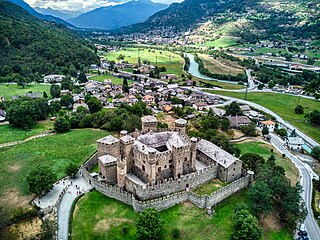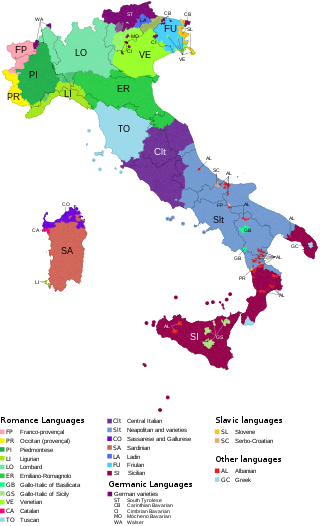Related Research Articles

Ladin is a Romance language of the Rhaeto-Romance subgroup, mainly spoken in the Dolomite Mountains in Northern Italy in the provinces of South Tyrol, Trentino, and Belluno, by the Ladin people. It exhibits similarities to Romansh, spoken in Switzerland, as well as Friulian, spoken in north-east Italy.

The Indus Valley Civilisation (IVC), also known as the Indus Civilisation, was a Bronze Age civilisation in the northwestern regions of South Asia, lasting from 3300 BCE to 1300 BCE, and in its mature form from 2600 BCE to 1900 BCE. Together with ancient Egypt and Mesopotamia, it was one of three early civilisations of the Near East and South Asia, and of the three, the most widespread, its sites spanning an area including much of modern day Pakistan, northwestern India and northeast Afghanistan. The civilisation flourished both in the alluvial plain of the Indus River, which flows through the length of Pakistan, and along a system of perennial monsoon-fed rivers that once coursed in the vicinity of the Ghaggar-Hakra, a seasonal river in northwest India and eastern Pakistan.

The Aosta Valley is a mountainous autonomous region in northwestern Italy. It is bordered by Auvergne-Rhône-Alpes, France, to the west; by Valais, Switzerland, to the north; and by Piedmont, Italy, to the south and east. The regional capital is Aosta.

Kashmiri or Koshur is a Dardic Indo-Aryan language spoken by around 7 million Kashmiris of the Kashmir region, primarily in the Kashmir Valley of the Indian-administrated union territory of Jammu and Kashmir, over half the population of that territory. Kashmiri has split ergativity and the unusual verb-second word order.

Franco-Provençal is a language within the Gallo-Romance family, originally spoken in east-central France, western Switzerland and northwestern Italy.
The Shoshone or Shoshoni are a Native American tribe with four large cultural/linguistic divisions:

South Wales is a loosely defined region of Wales bordered by England to the east and mid Wales to the north. Generally considered to include the historic counties of Glamorgan and Monmouthshire, south Wales extends westwards to include Carmarthenshire and Pembrokeshire. In the western extent, from Swansea westwards, local people would probably recognise that they lived in both south Wales and west Wales. The Brecon Beacons National Park covers about a third of south Wales, containing Pen y Fan, the highest British mountain south of Cadair Idris in Snowdonia.

Newar is a Sino-Tibetan language spoken by the Newar people, the indigenous inhabitants of Nepal Mandala, which consists of the Kathmandu Valley and surrounding regions in Nepal. The language is known officialy in Nepal as Nepal Bhasa, a name that has been historically used for the language. The term "Newari" is also used to refer to the language, although the Indic -i suffix is considered inappropriate by some Newar speakers.

The Dani are an ethnic group from the Central Highlands of Western New Guinea in Baliem Valley, Highland Papua, Indonesia. Around 100,000 people live in the Baliem Valley, consisting of representatives of the Dani tribes in the lower and upper parts of the valley each 20,000 and 50,000 in the middle part. The areas west of the Baliem Valley are inhabited by approx 180,000, representatives of the Lani people, incorrectly called "Western Dani". All inhabitants of Baliem Valley and the surrounding areas are often called Dani hence they are also sometimes conflated with other highland tribes such as Lani in the west; Walak in the north; Nduga, Mek, and Yali in the south and east.

Provincia autonoma di Trento, commonly known as Trentino, is an autonomous province of Italy in the country's far north. Trentino and South Tyrol constitute the region of Trentino-Alto Adige/Südtirol, an autonomous region under the constitution. The province is composed of 166 comuni. Its capital is the city of Trento (Trent). The province covers an area of more than 6,000 km2 (2,300 sq mi), with a total population of 541,098 in 2019. Trentino is renowned for its mountains, such as the Dolomites, which are part of the Alps.
Timbisha (Tümpisa) or Panamint is the language of the Native American people who have inhabited the region in and around Death Valley, California, and the southern Owens Valley since late prehistoric times. There are a few elderly individuals who can speak the language in California and Nevada, but none are monolingual, and all use English regularly in their daily lives. Until the late 20th century, the people called themselves and their language "Shoshone." The tribe then achieved federal recognition under the name Death Valley Timbisha Shoshone Band of California. This is an Anglicized spelling of the native name of Death Valley, tümpisa, pronounced, which means "rock paint" and refers to the rich sources of red ochre in the valley. Timbisha is also the language of the so-called "Shoshone" groups at Bishop, Big Pine, Darwin, Independence, and Lone Pine communities in California and the Beatty community in Nevada. It was also the language spoken at the former Indian Ranch reservation in Panamint Valley.

The languages of Italy include Italian, which serves as the country's national language, in its standard and regional forms, as well as numerous local and regional languages, most of which, like Italian, belong to the broader Romance group. The majority of languages often labeled as regional are distributed in a continuum across the regions' administrative boundaries, with speakers from one locale within a single region being typically aware of the features distinguishing their own variety from one of the other places nearby.

The Zapotec civilization is an indigenous pre-Columbian civilization that flourished in the Valley of Oaxaca in Mesoamerica. Archaeological evidence shows that their culture originated at least 2,500 years ago. The Zapotec archaeological site at the ancient city of Monte Albán has monumental buildings, ball courts, magnificent tombs and grave goods, including finely worked gold jewelry. Monte Albán was one of the first major cities in Mesoamerica. It was the center of a Zapotec state that dominated much of the territory which today is known as the Mexican state of Oaxaca.

The Dravidian peoples, Dravidian-speakers or Dravidians, are a collection of ethnolinguistic groups native to South Asia who speak Dravidian languages. There are around 250 million native speakers of Dravidian languages. Dravidian speakers form the majority of the population of South India and are natively found in India, Pakistan, Afghanistan, Bangladesh, the Maldives, Nepal, Bhutan and Sri Lanka. Dravidian peoples are also present in Singapore, Mauritius, Malaysia, France, South Africa, Myanmar, East Africa, the Caribbean, and the United Arab Emirates through recent migration.
The Dani or Baliem Valley languages are a family of clearly related Trans–New Guinea languages spoken by the Dani and related peoples in the Baliem Valley in the Highland Papua, Indonesia. Foley (2003) considers their Trans–New Guinea language group status to be established. They may be most closely related to the languages of Paniai Lakes, but this is not yet clear. Capell (1962) posited that their closest relatives were the Kwerba languages, which Ross (2005) rejects.
Grand Valley Dani, or simply Dani, is one of the most populous Papuan languages in Indonesian New Guinea. The Dani people live in the Baliem Valley of the Western Highlands.
Yali is a Papuan language of Indonesian New Guinea. The Yali people live east of the Baliem Valley, in the Western Highlands.

Nilambur Kovilakam, also known as Nilambur Kingdom, was a former vassal kingdom and royal Kovilakam in present-day Kerala, India, situated near the Nilgiri range of the Western Ghats. It was ruled by Samantha Kshatriyas of the Nagavanshi clan who were the family members and representatives of the Samoothiri Raja (Zamorin), and also kept marriage relations with the Nambudiris. They served as vassal kings to the Zamorins, with their capital located 25 kilometers north of Manjeri in present-day Malappuram district. They built several aristocratic Tharavads, such as the Nambudiri stronghold of Pootheri Illam in Feroke, and married into the Zamorin's own family from Nediyiruppu Swaroopam.
Sandy River Valley Sign Language was a village sign language of the 19th-century Sandy River Valley in Maine. Together with the more famous Martha's Vineyard Sign Language and Henniker Sign Language, it was one of three local languages which formed the basis of American Sign Language.
The Cagayan Valley languages are a group of languages spoken in the Philippines. They are: